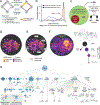A multi-scale map of protein assemblies in the DNA damage response
- PMID: 37220749
- PMCID: PMC10330685
- DOI: 10.1016/j.cels.2023.04.007
A multi-scale map of protein assemblies in the DNA damage response
Abstract
The DNA damage response (DDR) ensures error-free DNA replication and transcription and is disrupted in numerous diseases. An ongoing challenge is to determine the proteins orchestrating DDR and their organization into complexes, including constitutive interactions and those responding to genomic insult. Here, we use multi-conditional network analysis to systematically map DDR assemblies at multiple scales. Affinity purifications of 21 DDR proteins, with/without genotoxin exposure, are combined with multi-omics data to reveal a hierarchical organization of 605 proteins into 109 assemblies. The map captures canonical repair mechanisms and proposes new DDR-associated proteins extending to stress, transport, and chromatin functions. We find that protein assemblies closely align with genetic dependencies in processing specific genotoxins and that proteins in multiple assemblies typically act in multiple genotoxin responses. Follow-up by DDR functional readouts newly implicates 12 assembly members in double-strand-break repair. The DNA damage response assemblies map is available for interactive visualization and query (ccmi.org/ddram/).
Keywords: DNA damage response; double-strand break repair; multi-omics; protein assemblies; protein networks; single-strand break repair; systems biology; visualization.
Copyright © 2023 The Author(s). Published by Elsevier Inc. All rights reserved.
Conflict of interest statement
Declaration of interests T.I. is co-founder of Data4Cure, Inc., is on the Scientific Advisory Board, and has an equity interest. T.I. is on the Scientific Advisory Board of Ideaya BioSciences, Inc. and has an equity interest. The terms of these arrangements have been reviewed and approved by the University of California San Diego in accordance with its conflict of interest policies. R.W.S. is co-founder of Canal House Biosciences, LLC, is on the Scientific Advisory Board, and has an equity interest. N.J.K. is a shareholder of Tenaya Therapeutics and has received stocks from Maze Therapeutics and Interline Therapeutics; has consulting agreements with the Icahn School of Medicine at Mount Sinai, New York, Maze Therapeutics and Interline Therapeutics. The laboratory of N.J.K. has received research support from Vir Biotechnology and F. Hoffmann-La Roche.
Figures








